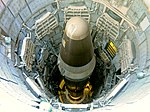Nuclear depth bomb
This article has multiple issues. Please help improve it or discuss these issues on the talk page. (Learn how and when to remove these messages)
|
| Part of a series on |
| History of the Cold War |
|---|
 |
A nuclear depth bomb is the nuclear equivalent of the conventional depth charge, and can be used in anti-submarine warfare for attacking submerged submarines. The British Royal Navy, Soviet Navy, and United States Navy had nuclear depth bombs in their arsenals at one point.

Due to the use of a nuclear warhead of much greater explosive power than that of the conventional depth charge, the nuclear depth bomb considerably increases the likelihood (to the point of near certainty) of the destruction of the attacked submarine.
Some aircraft were cleared for using these, such as the P-2V Neptune, but none were used against any submarines.
Because of this much greater power some nuclear depth bombs feature a variable yield, whereby the explosive energy of the device may be varied between a low setting for use in shallow or coastal waters, and a high yield for deep water open-sea use. This is intended to minimise damage to peripheral areas and merchant shipping.
All nuclear anti-submarine weapons were withdrawn from service by the United States, the United Kingdom, France, Russia, and China in or around 1990. They were replaced by conventional weapons such as the Mk.54 Torpedo that provided ever-increasing accuracy and range as anti-submarine warfare technology improved.
